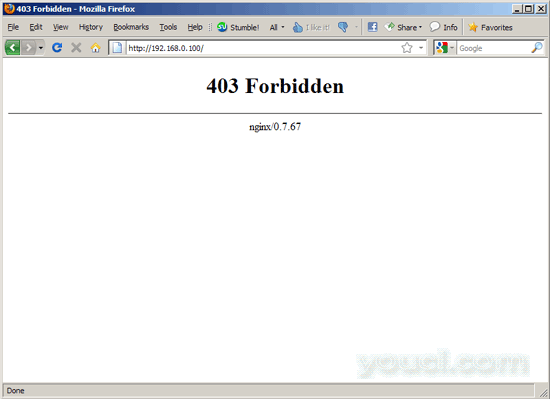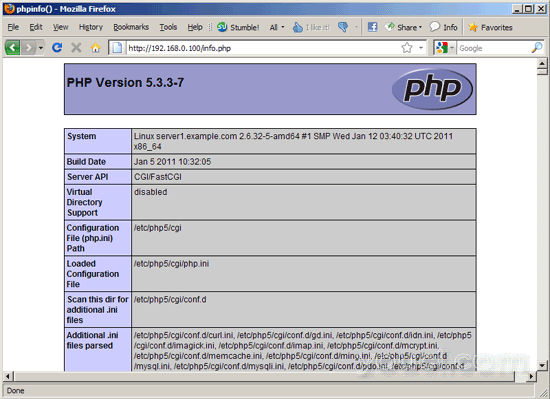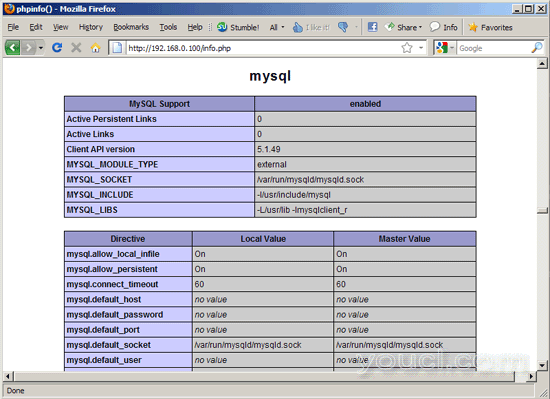安装Nginx与PHP5和MySQL支持Debian Squeeze
Nginx (发音为“引擎x”)是一个免费的,开放源码的高性能HTTP服务器。 Nginx以其稳定性,丰富的功能集,简单的配置和低资源消耗而闻名。 本教程将介绍如何在支持PHP5(通过FastCGI)和MySQL支持的Debian Squeeze服务器上安装Nginx。
我不会保证这将为您工作!
1初步说明
在本教程中,我使用IP地址为192.168.0.100的hostname server1.example.com 。 这些设置可能会有所不同,因此您必须在适当的情况下更换它们。
2安装MySQL 5
为了安装MySQL,我们运行
apt-get install mysql-server mysql-client
您将被要求为MySQL root用户提供密码 - 此密码对用户root @ localhost以及root@server1.example.com有效 ,因此我们不必在以后手动指定MySQL根密码:
MySQL“root”用户的新密码: < - yourrootsqlpassword
重复MySQL“root”用户的密码: < - yourrootsqlpassword
3安装Nginx
Nginx可作为Debian Squeeze的软件包提供,我们可以安装如下:
apt-get install nginx
之后启动nginx:
/etc/init.d/nginx start
默认的nginx文档根目录是/ var / www ,它不存在; 因此,我们必须创建如下:
mkdir /var/www
chown www-data:www-data /var/www
在浏览器中输入您的Web服务器的IP地址或主机名(例如http://192.168.0.100 ),您应该看到以下页面:

你得到一个403禁止的错误,因为/ var / www中没有索引页。
4安装PHP5
我们可以通过FastCGI使PHP5在nginx中工作。 幸运的是,Debian Squeeze提供了一个支持FastCGI的PHP5软件包,我们像这样安装一些PHP5软件包(如PHP PHP脚本,您需要使用PHP5的一些PHP5模块)
apt-get install php5-cgi php5-mysql php5-curl php5-gd php5-idn php-pear php5-imagick php5-imap php5-mcrypt php5-memcache php5-ming php5-pspell php5-recode php5-snmp php5-sqlite php5-tidy php5-xmlrpc php5-xsl
然后打开/etc/php5/cgi/php.ini并取消注释行cgi.fix_pathinfo = 1 :
vi /etc/php5/cgi/php.ini
[...] ; cgi.fix_pathinfo provides *real* PATH_INFO/PATH_TRANSLATED support for CGI. PHP's ; previous behaviour was to set PATH_TRANSLATED to SCRIPT_FILENAME, and to not grok ; what PATH_INFO is. For more information on PATH_INFO, see the cgi specs. Setting ; this to 1 will cause PHP CGI to fix its paths to conform to the spec. A setting ; of zero causes PHP to behave as before. Default is 1. You should fix your scripts ; to use SCRIPT_FILENAME rather than PATH_TRANSLATED. ; http://php.net/cgi.fix-pathinfo cgi.fix_pathinfo=1 [...] |
Debian Squeeze没有独立的FastCGI守护程序包,因此我们使用lighttpd的spawn-fcgi程序。 我们安装lighttpd如下:
apt-get install lighttpd
您将看到一条错误消息,指出lighttpd无法启动,因为端口80已被使用:
Starting web server: lighttpd2011-02-24 01:43:18: (network.c.358) can't bind to port: 80 Address already in use
failed!
invoke-rc.d: initscript lighttpd, action "start" failed.
这就是因为nginx已经在80端口上监听了
update-rc.d -f lighttpd remove
所以lighttpd在启动时不会启动。
我们已经安装了lighttpd,因为我们只需要一个包, / usr / bin / spawn-fcgi的程序 ,我们可以使用它来启动FastCGI进程。 看一眼
spawn-fcgi --help
了解更多信息。
要启动PHP FastCGI守护程序监听本地主机上的端口9000 ,并以用户和组www-data的身份运行,我们运行以下命令:
/usr/bin/spawn-fcgi -a 127.0.0.1 -p 9000 -u www-data -g www-data -f /usr/bin/php5-cgi -P /var/run/fastcgi-php.pid
当然,您不需要在引导系统时手动输入该命令,因此要让系统在引导时自动执行命令,请打开/etc/rc.local ...
vi /etc/rc.local
...并在文件末尾添加命令(在退出行之前):
[...] /usr/bin/spawn-fcgi -a 127.0.0.1 -p 9000 -u www-data -g www-data -f /usr/bin/php5-cgi -P /var/run/fastcgi-php.pid [...] |
5配置nginx
nginx配置在我们现在打开的/etc/nginx/nginx.conf中:
vi /etc/nginx/nginx.conf
配置很容易理解(您可以在这里了解更多信息: http : //wiki.codemongers.com/NginxFullExample ,这里: http : //wiki.codemongers.com/NginxFullExample2 )
首先(这是可选的)增加了工作进程的数量,并将keepalive_timeout设置为合理的值:
[...]
worker_processes 5;
[...]
keepalive_timeout 2;
[...] |
虚拟主机在server {}容器中定义。 默认的vhost在文件/ etc / nginx / sites-available / default中定义 - 让我们修改如下:
vi /etc/nginx/sites-available/default
[...]
server {
listen 80; ## listen for ipv4
listen [::]:80 default ipv6only=on; ## listen for ipv6
server_name _;
access_log /var/log/nginx/localhost.access.log;
location / {
root /var/www;
index index.php index.html index.htm;
}
location /doc {
root /usr/share;
autoindex on;
allow 127.0.0.1;
deny all;
}
location /images {
root /usr/share;
autoindex on;
}
#error_page 404 /404.html;
# redirect server error pages to the static page /50x.html
#
#error_page 500 502 503 504 /50x.html;
#location = /50x.html {
# root /var/www/nginx-default;
#}
# proxy the PHP scripts to Apache listening on 127.0.0.1:80
#
#location ~ \.php$ {
#proxy_pass http://127.0.0.1;
#}
# pass the PHP scripts to FastCGI server listening on 127.0.0.1:9000
#
location ~ \.php$ {
try_files $uri =404;
fastcgi_pass 127.0.0.1:9000;
fastcgi_index index.php;
fastcgi_param SCRIPT_FILENAME /var/www$fastcgi_script_name;
include fastcgi_params;
}
# deny access to .htaccess files, if Apache's document root
# concurs with nginx's one
#
location ~ /\.ht {
deny all;
}
}
[...] |
服务器名称 _; 使它成为默认的catchall vhost(当然,您也可以像www.example.com一样指定一个主机名)。
在位置/部分,我已经将index.php添加到索引行。 root / var / www; 意味着文档根目录是/ var / www 。
PHP的重要部分是位置〜\ .php $ {}节。 取消注释以启用它。 请确保将fastcgi_param行更改为fastcgi_param SCRIPT_FILENAME / var / www $ fastcgi_script_name; (使用vhost的文档根替换/ var / www ),否则PHP解释器将找不到您在浏览器中调用的PHP脚本。
确保include和fastcgi_params之间有一些空格; - 在默认文件中,这是一个单词,这是一个错误。
现在保存文件并重启nginx:
/etc/init.d/nginx restart
现在在文件root / var / www中创建以下PHP文件:
vi /var/www/info.php
<?php phpinfo(); ?> |
现在我们在浏览器中调用该文件(例如http://192.168.0.100/info.php ):

如您所见,PHP5正在工作,它正在通过FastCGI工作,如Server API行所示。 如果您进一步向下滚动,您将看到在PHP5中已经启用的所有模块,包括MySQL模块:

6链接
- nginx: http : //nginx.net/
- nginx维基: http : //wiki.codemongers.com/Main
- PHP: http : //www.php.net/
- MySQL: http : //www.mysql.com/
- Debian: http : //www.debian.org/
关于作者

Falko Timme是所有者  Timme Hosting(超快nginx网页托管)。 他是youcl(自2005年以来)的主要维护者, 也是ISPConfig的核心开发人员之一 (自2000年起)。 他还为O'Reilly的“Linux系统管理”一书作出了贡献。
Timme Hosting(超快nginx网页托管)。 他是youcl(自2005年以来)的主要维护者, 也是ISPConfig的核心开发人员之一 (自2000年起)。 他还为O'Reilly的“Linux系统管理”一书作出了贡献。








